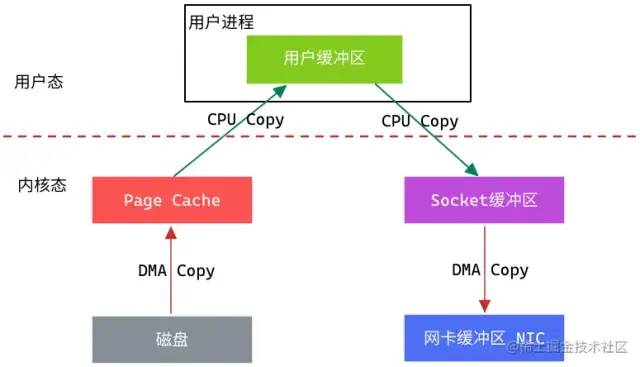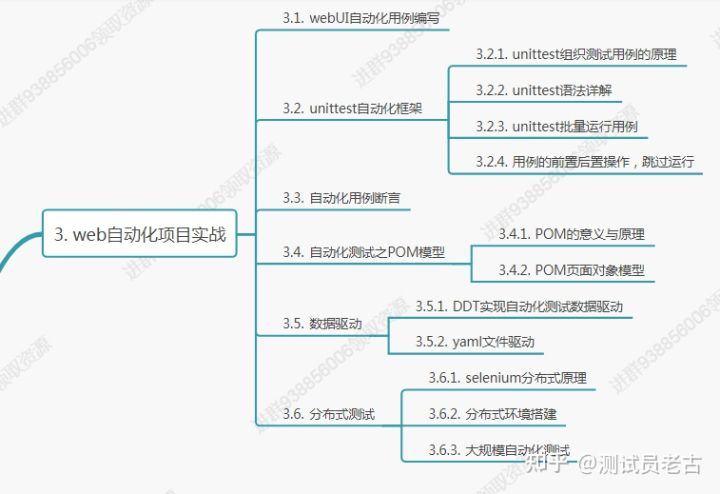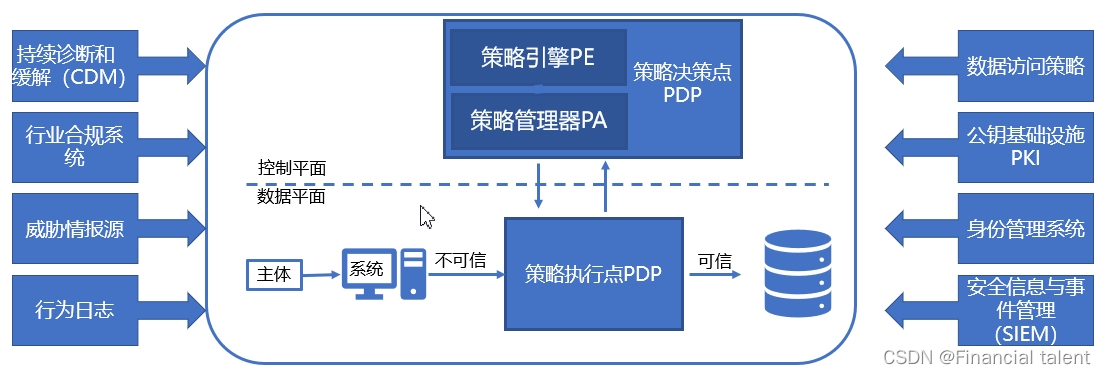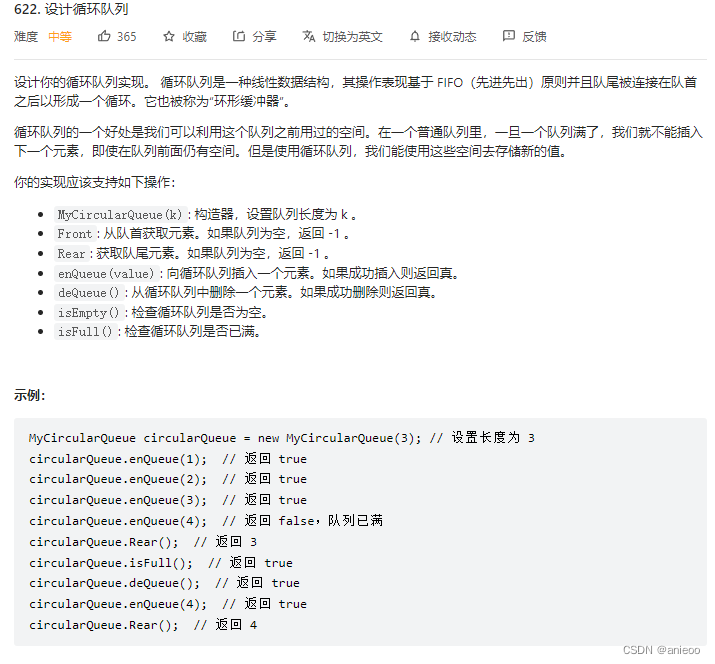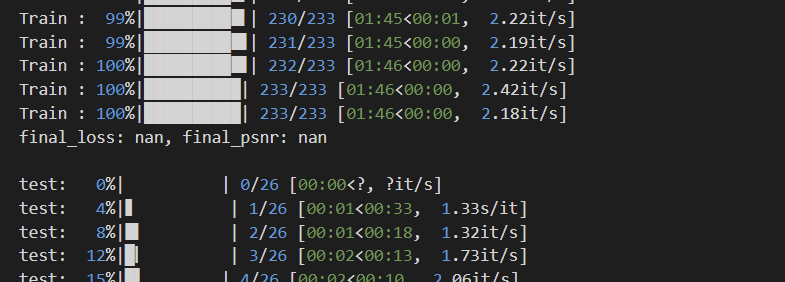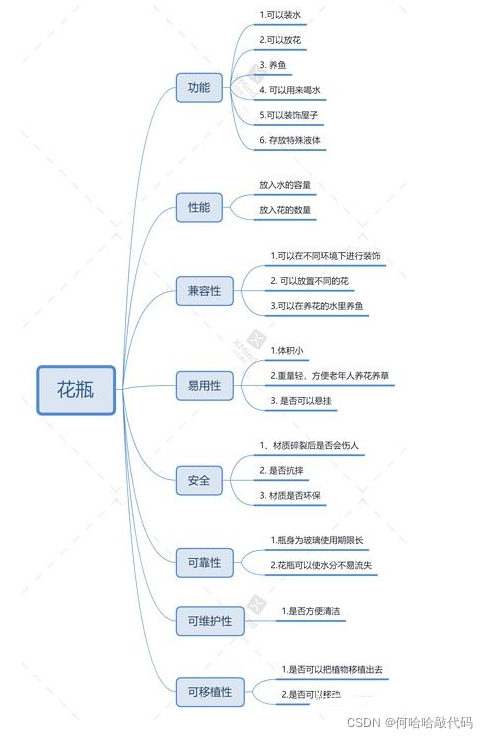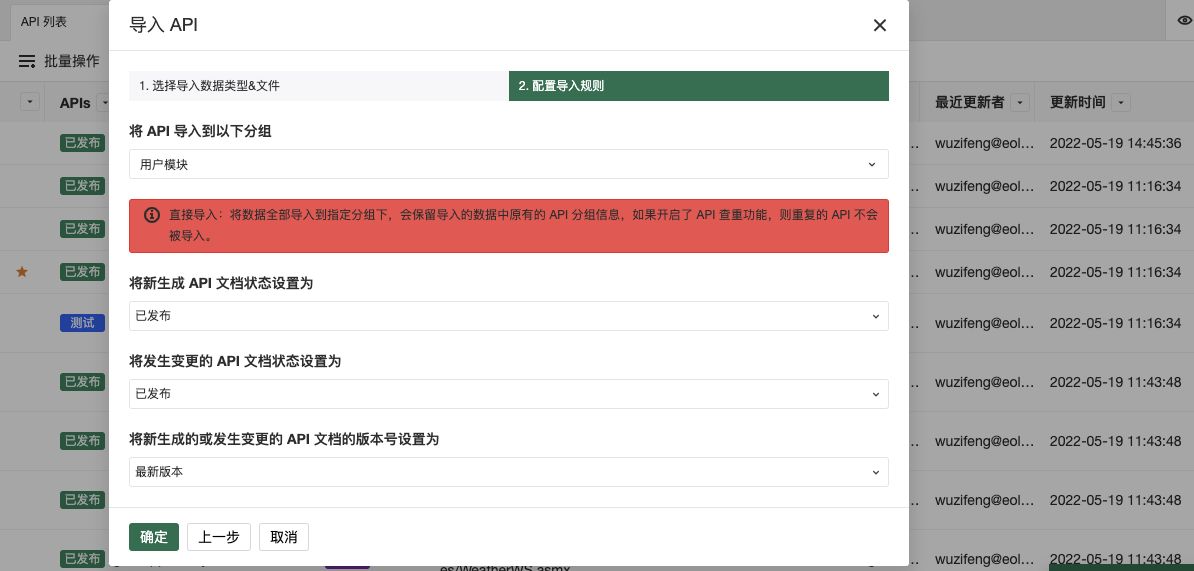当前位置:网站首页>特征降维学习笔记(pca和lda)(1)
特征降维学习笔记(pca和lda)(1)
2022-08-03 12:02:00 【羊咩咩咩咩咩】
现在存在两种主流的降维方式:投影与流形学习,投影是指将高维数据投影在低维度的平面上,但是可能导致子空间旋转扭曲。而流形学习依赖于流形设计,流形设计主要认为现实世界高维数据集接近于低维度流体。
主成分分析(PCA):它是通过识别靠近数据的超平面进行投影,本质上是通过比较原始数据集,到新平面的方差最小,则为第一主成分,当第二个主成分与第一个组成分的协方差为0,说明不相关,则为第二个主成分,以此类推。
使用python计算pca:
import numpy as np
np.random.seed(4)
m = 60
w1, w2 = 0.1, 0.3
noise = 0.1
angles = np.random.rand(m) * 3 * np.pi / 2 - 0.5
X = np.empty((m, 3))
X[:, 0] = np.cos(angles) + np.sin(angles)/2 + noise * np.random.randn(m) / 2
X[:, 1] = np.sin(angles) * 0.7 + noise * np.random.randn(m) / 2
X[:, 2] = X[:, 0] * w1 + X[:, 1] * w2 + noise * np.random.randn(m)
X_centered = X-X.mean(axis=0)
U,S,Vt =np.linalg.svd(X_centered)
c1 = Vt.T[:,0]
c2 = Vt.T[:,1]
w2 =Vt.T[:,:2]
X2D = X_centered.dot(w2)
X2D这里使用了svd方法(奇异值分解),它的作用是旋转坐标轴,进行拉伸后再进行旋转,计算均值的目的是在计算主成分的过程中,需要得到每一类主成分的均值,进而使每一类主成分的均值点距离最大,而每一类样本点中间的差异最小。
使用sklearn中的decomposition的pca方法进行模拟
from sklearn.decomposition import PCA
pca =PCA(n_components=2)
X_2D =pca.fit_transform(X)
pca.components_.T[:,0]##第一个主成分的单位向量在主成分分析中,有一类方法,累计求主成分的和,当总的主成分大于95%时,就取这些主成分作为全部分成进行计算。
pca.explained_variance_ratio_##可解释方差比,说明前两个主成分的方差占比这里使用pca的函数explained_variance_ratio可解释方差,本质是就是特征的重要性。
from sklearn.datasets import fetch_openml
mnist = fetch_openml('mnist_784', version=1, as_frame=False)
mnist.target = mnist.target.astype(np.uint8)
from sklearn.model_selection import train_test_split
X = mnist["data"]
y = mnist["target"]
X_train, X_test, y_train, y_test = train_test_split(X, y)
pca = PCA()
pca.fit_transform(X_train)
cumsum = np.cumsum(pca.explained_variance_ratio_)##对数据按行求和
d = np.argmax(cumsum>0.95)+1也可以通过pca的超参数进行设置
pca = PCA(n_components=0.95)
X_reduced = pca.fit_transform(X_train)也可以在pca中设置参数,对数据进行压缩
##使用pca进行压缩
pca = PCA(n_components=154)
x_reduced = pca.fit_transform(X_train)
x_reversed = pca.inverse_transform(x_reduced)pca.inverse_transform可以将压缩特征进行还原。
随机pca:快速找到前d个主成分的近似值。pca中的svd_solver='randomized'
rnd_pca = PCA(n_components=154,svd_solver = 'randomized')
x_reduced = rnd_pca.fit_transform(X_train)
rnd_pca.explained_variance_ratio_.sum()增量pca:将小批量的数据送入内存进行降维,完成后再输入少量数据,增加运行速度,同时节约了内存空间。这里使用了sklearn.decomposition.incrementalPCA
from sklearn.decomposition import IncrementalPCA
IPCA =IncrementalPCA(n_components=154)
n_batches=100
for x_batch in np.array_split(X_train,n_batches):
IPCA.partial_fit(x_batch)
x_reduced =IPCA.transform(X_train)也可以使用np.menmap类进行操作。
filename = "my_mnist.data"
m, n = X_train.shape
X_mm = np.memmap(filename, dtype='float32', mode='write', shape=(m, n))
X_mm[:] = X_train
X_mm = np.memmap(filename, dtype="float32", mode="readonly", shape=(m, n))
batch_size = m // n_batches
inc_pca = IncrementalPCA(n_components=154, batch_size=batch_size)
inc_pca.fit(X_mm)内核pca:可以解决非线性的复杂投影,可以使用网格化搜索GridSearchCV进行筛选。
from sklearn.decomposition import KernelPCA
from sklearn.datasets import make_swiss_roll
X, t = make_swiss_roll(n_samples=1000, noise=0.2, random_state=42)
rbf_pca = KernelPCA(n_components=2,kernel='rbf',gamma=0.04)
x_reduced = rbf_pca.fit_transform(X)
from sklearn.decomposition import KernelPCA
import matplotlib.pyplot as plt
lin_pca = KernelPCA(n_components = 2, kernel="linear", fit_inverse_transform=True)
rbf_pca = KernelPCA(n_components = 2, kernel="rbf", gamma=0.0433, fit_inverse_transform=True)
sig_pca = KernelPCA(n_components = 2, kernel="sigmoid", gamma=0.001, coef0=1, fit_inverse_transform=True)
y = t > 6.9
plt.figure(figsize=(11, 4))
for subplot, pca, title in ((131, lin_pca, "Linear kernel"), (132, rbf_pca, "RBF kernel, $\gamma=0.04$"), (133, sig_pca, "Sigmoid kernel, $\gamma=10^{-3}, r=1$")):
X_reduced = pca.fit_transform(X)
if subplot == 132:
X_reduced_rbf = X_reduced
plt.subplot(subplot)
#plt.plot(X_reduced[y, 0], X_reduced[y, 1], "gs")
#plt.plot(X_reduced[~y, 0], X_reduced[~y, 1], "y^")
plt.title(title, fontsize=14)
plt.scatter(X_reduced[:, 0], X_reduced[:, 1], c=t, cmap=plt.cm.hot)
plt.xlabel("$z_1$", fontsize=18)
if subplot == 131:
plt.ylabel("$z_2$", fontsize=18, rotation=0)
plt.grid(True)
plt.show()
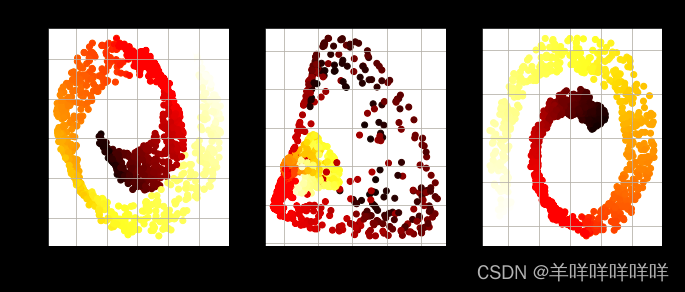
from sklearn.model_selection import GridSearchCV
from sklearn.linear_model import LogisticRegression
from sklearn.pipeline import Pipeline
clf = Pipeline([
("kpca", KernelPCA(n_components=2)),
("log_reg", LogisticRegression(solver="lbfgs"))
])
param_grid = [{
"kpca__gamma": np.linspace(0.03, 0.05, 10),
"kpca__kernel": ["rbf", "sigmoid"]
}]
grid_search = GridSearchCV(clf, param_grid, cv=3)
grid_search.fit(X, y)
print(grid_search.best_params_)
rbf_pca = KernelPCA(n_components=2,kernel='rbf',gamma=0.0433,fit_inverse_transform=True)
x_reduced = rbf_pca.fit_transform(X)
X_preimage =rbf_pca.inverse_transform(X_reduced)
from sklearn.metrics import mean_squared_error
mean_squared_error(X,X_preimage)习题:使用MNIST数据集训练随机森林分类器,测试其花的时间与性能,然后进行降维后,判断其花费时间与性能,进行比较。
from sklearn.datasets import fetch_openml
mnist = fetch_openml('mnist_784', version=1, as_frame=False)
mnist.target = mnist.target.astype(np.uint8)
X = mnist['data']
Y = mnist['target']
from sklearn.model_selection import train_test_split
x_train,x_test,y_train,y_test =train_test_split(X,Y,test_size=10000)
from sklearn.ensemble import RandomForestClassifier
import time
rfc = RandomForestClassifier()
start_time =time.time()
rfc.fit(x_train,y_train)
end_time = time.time()
print(end_time-start_time)
from sklearn.decomposition import PCA
PCA = PCA(n_components=0.95)
x_reduced_train = PCA.fit_transform(x_train)
rfc_pca = RandomForestClassifier()
start_time =time.time()
rfc_pca.fit(x_reduced_train,y_train)
end_time = time.time()
print(end_time-start_time)
from sklearn.metrics import mean_squared_error
from sklearn.metrics import accuracy_score
def model_descirbe(model,x_test):
y_pred = model.predict(x_test)
print('mse',mean_squared_error(y_pred,y_test))
print('accuracy',accuracy_score(y_pred,y_test))
model_descirbe(rfc)
x_reduced_test = PCA.transform(x_test)
model_descirbe(rfc_pca,x_reduced_test)结果发现:降维后训练时间边长,而且均方误差与正确率都低于没有降维的
边栏推荐
- 字节最爱问的智力题,你会几道?
- html网页如何获取后台数据库的数据(html + ajax + php + mysql)
- Vs Shortcut Keys---Explore Different Programming
- 苹果发布 AI 生成模型 GAUDI,文字生成 3D 场景
- 面试官:SOA 和微服务的区别?这回终于搞清楚了!
- LyScript 实现对内存堆栈扫描
- 项目概述、推送和存储平台准备
- 优维低代码:Provider 构件
- pandas连接oracle数据库并拉取表中数据到dataframe中、筛选当前时间(sysdate)到一天之前的所有数据(筛选一天范围数据)
- C language advanced article: memory function
猜你喜欢
随机推荐
数据库系统原理与应用教程(076)—— MySQL 练习题:操作题 160-167(二十):综合练习
码率vs.分辨率,哪一个更重要?
4500字归纳总结,一名软件测试工程师需要掌握的技能大全
JUC(三):锁核心类AQS ing
小身材有大作用——光模块寿命分析(二)
What knowledge points do you need to master to learn software testing?
数据库系统原理与应用教程(075)—— MySQL 练习题:操作题 151-159(十九):综合练习
FR9811S6 SOT-23-6 23V, 2A Synchronous Step-Down DC/DC Converter
【一起学Rust】Rust学习前准备——注释和格式化输出
零拷贝、MMAP、堆外内存,傻傻搞不明白...
opencv学习—VideoCapture 类基础知识「建议收藏」
Vs 快捷键---探索不一样的编程
ROS中编译通过但是遇到可执行文件找不到的问题
项目概述、推送和存储平台准备
一次内存泄露排查小结
Generate interface documentation online
PC client automation testing practice based on Sikuli GUI image recognition framework
流式编程使用场景
Matlab学习13-图像处理之可视化GUI程序
微信小程序获取手机号

